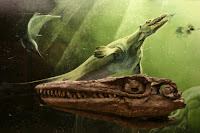Since the CFDC is most famous for its mosasaurs (I'm sure most of you have heard of Bruce, for example), I thought I'd focus on them in this week's blog for the purposes of clarifying what they actually are and why they're so impressive and important. As you'll soon see, there's a lot more to them than being big, swimming lizards with lots of teeth.
 |
Bruce, at 43 feet long, is the
biggest Tylosaur in Canada. |
To begin: when we refer to a "mosasaur", we usually mean a extinct member of the
Mosasauridae family of reptiles; three of its six known subfamilies are represented at our museum. An analogy I often use during tours is to liken mosasaurs to bears; just like there are many different kinds of bears, there are all sorts of different mosasaurs! The smallest kind of mosasaur we find is called
Clidastes, which could grow to about 13-15 feet long, while our biggest mosasaurs, which were called Tylosaurs (Bruce is one of these) could grow up to 43 feet long. The CFDC also has some medium-size specimens named
Platecarpus and
Plioplatecarpus.
Despite these drastic size differences, our mosasaurs are morphologically very similar, which means that their body structures look more or less the same (but not exactly so). Their hunting habits would have been related as well;
Clidastes would have eaten smaller fish, turtles, and marine birds, while Tylosaurs would have had a similar diet except on a much larger scale. Due to its small size,
Clidastes also served as a prey animal for bigger mosasaurs, a few fish (like
Xiphactinus and the
Cretoxyrhina shark), and giant squid; a fully grown Tylosaur, on the other hand, would have been invincible to nearly everything except disease and old age.
 |
| Clidastes skull. |
I should note that mosasaurs are marine reptiles,
not dinosaurs (as they're often erroneously called), although they co-existed in the same time period; dinosaurs and marine reptiles are from totally different evolutionary lineages. Mosasaurs superficially resemble crocodilians with long tails and flippers instead of proper feet for terrestrial movement, but these groups aren't closely related either; the closest thing you'll get to a mosasaur today are monitor lizards like the Komodo dragon.
 |
| Bruce and Scotty, a T. rex from Eastend, Sask. |
At their time of existence, mosasaurs were abundant all over the globe; Tylosaurs, in particular, were the dominant predators in the Western Interior Seaway, a massive body of water that bisected North America and connected the Arctic Ocean to the Gulf of Mexico. This is evident in their big teeth and long, powerful bodies, but Tylosaurs also had some neat hunting techniques that increased their predatory efficiency and reinforced their position at the top of the marine food chain. Their first trick lay in their quadrates, which are bones common to all squamates (a group that encompasses most reptiles) that were located at the back of their jaws. Like snakes, Tylosaurs (and mosasaurs in general) could unhinge both their quadrates and their lower jaw bones, augmenting their bite radii to such an extent that a Tylosaur like Bruce would have been able to fit an entire adult T. rex skull in its mouth (not that this would ever probably happen).
Once a mosasaur has prey in its mouth, a second technique, in the form of pterygoid teeth, goes to work. Pterygoid teeth are a second set of teeth, comprised of two columns, that are located at the top of a mosasaur's mouth. Once a prey animal is hooked on these teeth, the two columns go forward and backward very quickly, creating a shredding effect that essentially turns the mosasaur's mouth into a blender and renders the prey into so many tiny chunks. Once this is achieved, the mosasaur is free to swallow its food and look for its next meal.
 |
| The new Tylosaurus coin. |
Because of these adaptations, mosasaurs quickly outcompeted other large marine fauna like sharks and plesiosaurs (another kind of extinct marine reptile). However, their numbers gradually dwindled as the Cretaceous period came to a close and they went extinct, along with 65% of life on earth, around the same time that an upsurge of violent global volcanic activity and a devastating meteor impact where Mexico is today ended the Mezozoic era, paving the way for mammals to establish themselves both as a dominant presence on land and a significant force in the oceans. Unfortunately (or thankfully, depending on your perspective), we only find the fossilized remains of mosasaurs today; no remnants of the family are extant.
Coincidentally, the Royal Canadian Mint has recently designed a limited edition 25-cent coin that features a glow-in-the-dark Tylosaur. It costs around $30 and is available for pre-order through the Mint; once it's released come September, you'll be able to purchase one here at the CFDC as well.
Matt Remple
Field Tech




Comments